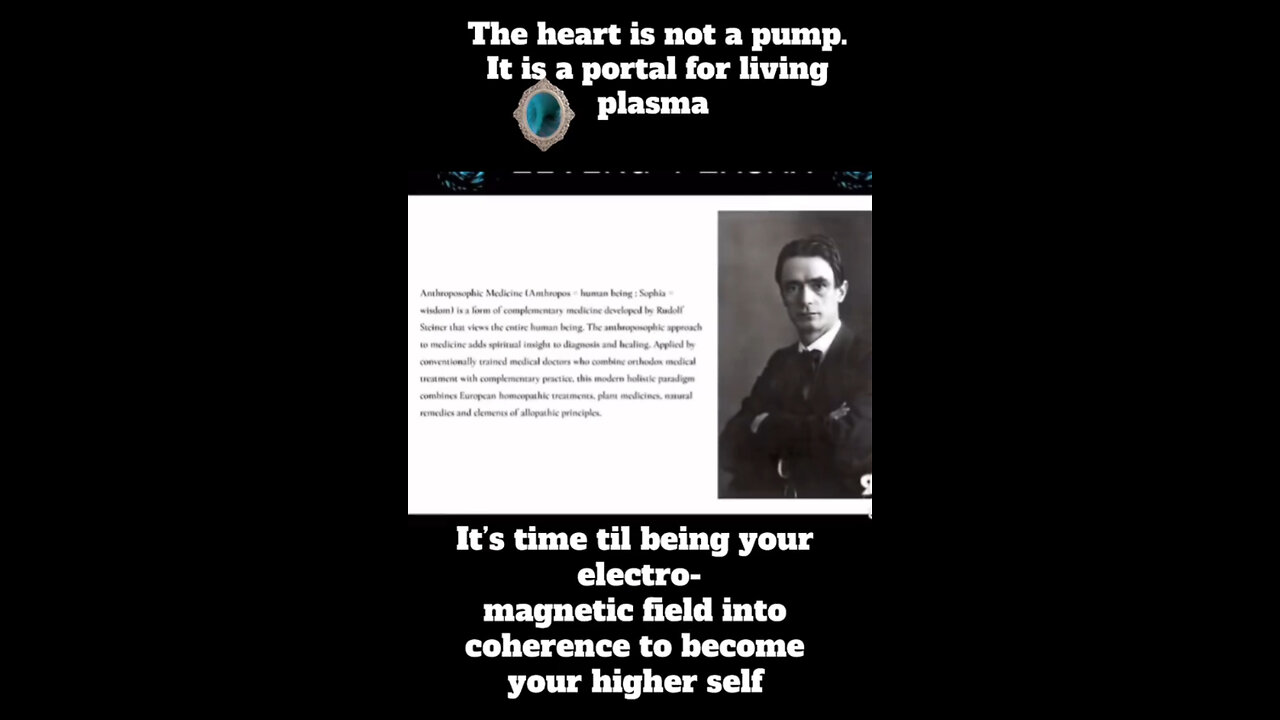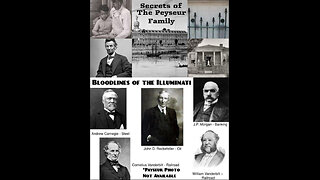Premium Only Content

Beyond the Beating Pump: Unveiling the Heart as a Vortex of Life
For centuries, the heart has been viewed as the body’s engine, a simple pump that mechanically pushes blood through our veins and arteries. Yet, visionary thinkers like Rudolf Steiner, along with recent scientific pioneers, suggest something vastly different: the heart as a sophisticated vortex generator, a conduit of energy, geometry, and consciousness. This revolutionary model offers a profound glimpse into the heart’s deeper function, revealing a holistic perspective that redefines our understanding of human life.
1. A Hidden Geometry: The Heart’s Seven-Sided Mystery
Rudolf Steiner, a mystic and philosopher whose teachings gave rise to anthroposophical medicine, biodynamic farming, and the Waldorf education system, proposed that the heart is far more than a physical pump. He described it as a seven-sided regular form situated in an “imaginary box” in the chest. While Plato described five Platonic solids, Steiner hinted at a sixth—a form that would eventually come to light through the work of Frank Chester.
Chester, an artist and geometrician, embarked on a quest to realize this elusive shape, eventually discovering the chestahedron: a seven-sided, identical-faced polyhedron. This form, remarkable in its symmetry, fits seamlessly within a cube at a 36-degree angle—precisely the same angle as the human heart in the chest. When immersed in water and spun, the chestahedron forms two counter-rotating vortices, mirroring the movements found within the heart’s structure. This discovery indicates that the heart’s function is inherently geometric and fluid, orchestrating blood flow through a series of energetic vortices rather than sheer mechanical force.
2. The Heart as a Vortex Generator: Redefining the Flow of Life
This reimagining of the heart was further validated by Paco Torrent Gwasp, a researcher who dissected countless hearts to uncover their secrets. His work revealed the heart to be a single, spiraling muscular band, wound upon itself to create a pattern of contraction that guides blood in a spiraling flow. The heart, Gwasp found, does not merely pump; it generates vortex-like currents within its chambers, directing blood through a double-spiral pathway.
This notion of the heart as a vortex generator aligns with the work of Victor Schauberger, a naturalist and water researcher who discovered that water in nature flows in spirals and vortices. Schauberger’s findings suggested that this spiral action structures water, endowing it with life-giving properties. Applying this insight to the human heart, we see that it functions as a vortex machine, structuring the blood as it moves and creating a field of coherent energy that sustains life throughout the body. The heart, then, is a living spiral, a nexus where the body’s energies converge and are renewed.
3. The Role of Structured Water: The Body’s Natural Propulsion System
Understanding the heart as a vortex generator brings us to the nature of water itself. Human cells are made up of approximately 70% water, yet recent research has shown that much of this water does not exist in any traditional state—solid, liquid, or vapor. Scientists now identify a fourth state of water, known as structured water, exclusion-zone (EZ) water, or gel-phase water. This structured water, a crystalline, negatively charged form, fills the body’s cellular spaces, forming a gelatinous layer along the walls of our capillaries, veins, and arteries.
Structured water is far from inert. It operates as an electrical propulsion system, propelling positively charged “bulk” water along with it through the cardiovascular system. Fueled by infrared energy from sunlight, the Earth’s electromagnetic field, and even our positive thoughts, structured water continuously sustains this propulsion, creating a self-renewing, energy-efficient system that defies conventional mechanics. This model suggests that, rather than the heart pumping blood, it is the flow of structured water that drives blood circulation—a system powered by nature’s own subtle energies.
4. The Heart of Consciousness: Thoughts, Emotions, and Energetic Resonance
The work of Dr. Masaru Emoto reveals another layer to this paradigm. Emoto’s studies showed that water exposed to positive human intentions—words, thoughts, and emotions—would form beautiful, crystalline hexagonal structures, while water subjected to negative words would produce chaotic, distorted forms. This discovery suggests that our intentions, emotions, and thoughts can directly influence the structure of water, shaping it into patterns that reflect our inner states.
In light of Emoto’s work, the heart emerges as an engine of energetic resonance, translating our thoughts and feelings into physical patterns within the body’s structured water. This perspective aligns with ancient teachings that describe the heart as a center of consciousness, a bridge between the physical and energetic bodies. When we experience emotions of love, joy, and gratitude, the structured water within our heart and blood vessels aligns harmoniously, creating a flow that promotes health and vitality. Conversely, stress, anger, and fear disrupt this harmony, weakening the heart’s energetic coherence.
5. Alchemy in the Heart: Monatomic Gold and the Spark of Life
Dr. Tom Cowan, a modern researcher inspired by these esoteric teachings, introduced an intriguing hypothesis: that the trace amounts of gold in our blood may transform into monatomic, or single-atom, gold as they pass through the heart’s vortices. Monatomic gold has unique properties; it appears white, can levitate, and possesses superconductive qualities. Alchemists throughout history pursued monatomic gold as a substance of spiritual and physical transformation, a material believed to bridge the finite and the infinite.
Cowan theorizes that, as blood spirals through the heart’s double vortices, the gold in our bloodstream undergoes an alchemical transformation into monatomic gold, creating a flash of energy—a “spark of life” that charges and renews the body. This process would imbue the heart with a subtle, superconductive energy, a dynamic force that connects us to a higher vibrational frequency and powers the body’s biofield.
6. Vortex as the Engine of Life: The Implication of Schauberger’s Work
Victor Schauberger’s lifelong study of water’s natural patterns led him to believe that vortices not only structure water but also generate energy. He described this as “implosion energy,” a force generated by inward-spiraling motion, in contrast to the explosive energy released in combustion. This implosion energy could explain the heart’s capacity to generate a self-sustaining, coherent flow of blood. Just as Schauberger’s water vortices created energy out of seemingly nothing, the heart’s vortices may harness an implosive, regenerative force, creating a field of vitality that sustains the body beyond mere mechanics.
Schauberger’s theories offer a radical shift in understanding energy itself, suggesting that life’s true power comes not from destruction but from the self-renewing, inward spiraling of energy. In the heart, this implosive force may represent the very essence of life—a perpetual, inward flow of energy that nourishes us, regenerating each cell, each breath, each heartbeat.
7. Implications for Health and Humanity: Connecting to the Source
This new model of the heart invites us to reimagine health as an energetic harmony, a coherent resonance with the forces that surround us. The heart is not merely a physical organ but a holographic bridge, connecting us to the Earth, to the cosmos, and to each other. Health, then, becomes a practice of aligning ourselves with the natural rhythms of life, of nurturing the energy fields within and around us.
To sustain this harmony, we are called to connect with the Earth, drawing upon its electromagnetic field, to bask in sunlight and absorb infrared energy, and to cultivate positive thoughts, emotions, and loving intentions. In doing so, we energize the structured water within us, fueling the flow of life with a continuous, self-renewing force. The heart, in this view, becomes a conduit of creation itself, a cosmic engine fueled by light, love, and intention.
Conclusion: The Heart as the Nexus of Life’s Mystery
In understanding the heart as a vortex of consciousness, we bridge the gap between science and spirituality, embracing a model that places the human being in the center of a living, breathing cosmos. We see that life flows not from mechanical parts but from the conscious, resonant energy of creation itself. The heart is not simply a pump; it is a generator, an alchemical vessel, and a bridge to the infinite.
This perspective invites us to live in harmony with these forces—to recognize that health, vitality, and the spark of life are sustained through our relationship with the world around us and the energy we bring to it. By viewing the heart as a vortex machine, we reclaim our role as co-creators of our health and reality, transforming our understanding of what it means to be truly alive.
-
 3:03
3:03
FragmentsOfTruth
1 day agoThe Paysuer Family: The Hidden Dynasty Controlling America?
1341 -
 38:41
38:41
Sarah Westall
6 hours agoHealth Freedom Under Attack, Dr Robert Young Found Guilty on Suspicious Victimless Crime, Matt Hazen
24.1K3 -
 LIVE
LIVE
Vigilant News Network
5 hours agoDataRepublican Exposes the Shadow Government’s Darkest Secrets - Exclusive Interview | Media Blackout
1,726 watching -
 31:39
31:39
Peter Santenello
1 year agoStories From Vegas' Golden Era 🇺🇸
33K23 -
 LIVE
LIVE
The Why Files
9 hours agoLIVE: The Why Files 24/7 Stream n' Chat
1,343 watching -
 55:15
55:15
Russell Brand
1 day agoThe Truth About Big Pharma & COVID with Dr. Aseem Malhotra
151K7 -
 1:19:48
1:19:48
The Rubin Report
9 hours agoWhat the Trump Administration Must Do Instead of Revenge | Peter Thiel
109K163 -
 1:59:00
1:59:00
Steve-O's Wild Ride! Podcast
3 days ago $35.57 earnedPatrick Bet-David DESTROYS Steve-O's Dad - Wild Ride #252
136K48 -
![[XboxONE] GRINDING 1000g FC24](https://1a-1791.com/video/fwe1/01/s8/1/y/k/I/o/ykIoy.0kob-small-XboxONE-GRINDING-1000g-FC24.jpg) 3:29:15
3:29:15
deathbee
12 hours ago[XboxONE] GRINDING 1000g FC24
91.9K10 -
 1:08:32
1:08:32
Winston Marshall
1 day agoThe HIDDEN Agenda: Congresswoman Hageman UNCOVERS USAID Fraud, Censorship and Human Trafficking
119K138